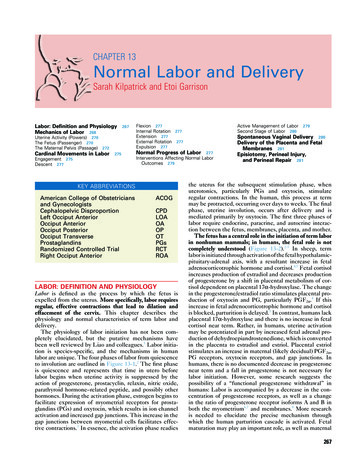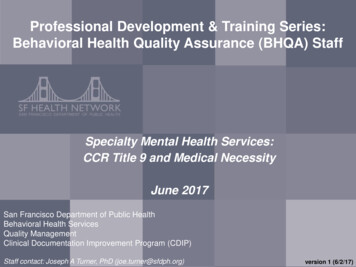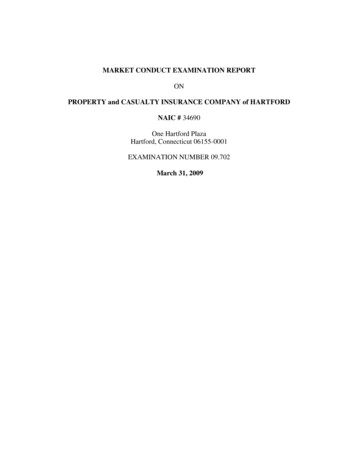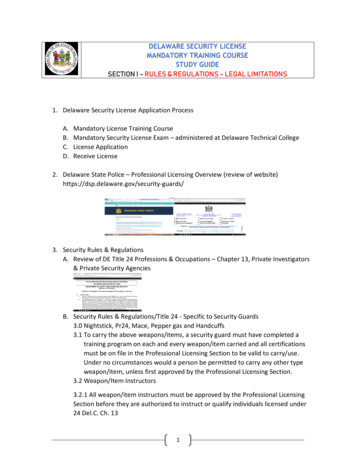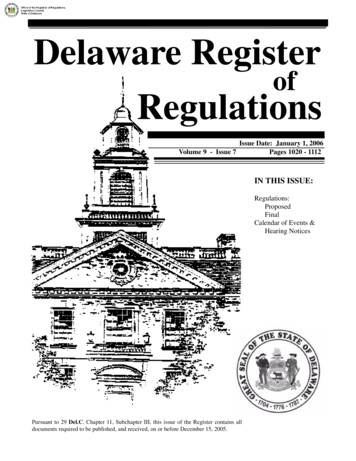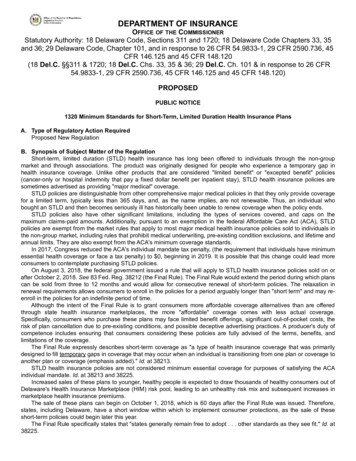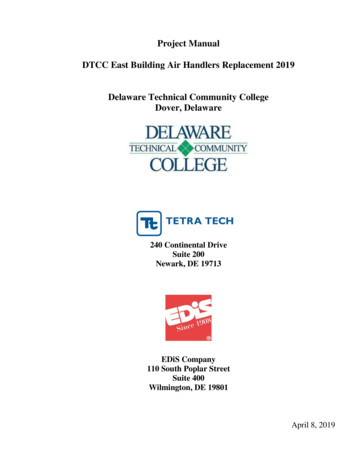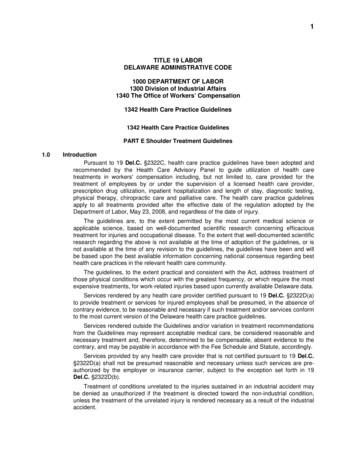
Transcription
1TITLE 19 LABORDELAWARE ADMINISTRATIVE CODE1000 DEPARTMENT OF LABOR1300 Division of Industrial Affairs1340 The Office of Workers’ Compensation1342 Health Care Practice Guidelines1342 Health Care Practice GuidelinesPART E Shoulder Treatment Guidelines1.0IntroductionPursuant to 19 Del.C. §2322C, health care practice guidelines have been adopted andrecommended by the Health Care Advisory Panel to guide utilization of health caretreatments in workers' compensation including, but not limited to, care provided for thetreatment of employees by or under the supervision of a licensed health care provider,prescription drug utilization, inpatient hospitalization and length of stay, diagnostic testing,physical therapy, chiropractic care and palliative care. The health care practice guidelinesapply to all treatments provided after the effective date of the regulation adopted by theDepartment of Labor, May 23, 2008, and regardless of the date of injury.The guidelines are, to the extent permitted by the most current medical science orapplicable science, based on well-documented scientific research concerning efficacioustreatment for injuries and occupational disease. To the extent that well-documented scientificresearch regarding the above is not available at the time of adoption of the guidelines, or isnot available at the time of any revision to the guidelines, the guidelines have been and willbe based upon the best available information concerning national consensus regarding besthealth care practices in the relevant health care community.The guidelines, to the extent practical and consistent with the Act, address treatment ofthose physical conditions which occur with the greatest frequency, or which require the mostexpensive treatments, for work-related injuries based upon currently available Delaware data.Services rendered by any health care provider certified pursuant to 19 Del.C. §2322D(a)to provide treatment or services for injured employees shall be presumed, in the absence ofcontrary evidence, to be reasonable and necessary if such treatment and/or services conformto the most current version of the Delaware health care practice guidelines.Services rendered outside the Guidelines and/or variation in treatment recommendationsfrom the Guidelines may represent acceptable medical care, be considered reasonable andnecessary treatment and, therefore, determined to be compensable, absent evidence to thecontrary, and may be payable in accordance with the Fee Schedule and Statute, accordingly.Services provided by any health care provider that is not certified pursuant to 19 Del.C.§2322D(a) shall not be presumed reasonable and necessary unless such services are preauthorized by the employer or insurance carrier, subject to the exception set forth in 19Del.C. §2322D(b).Treatment of conditions unrelated to the injuries sustained in an industrial accident maybe denied as unauthorized if the treatment is directed toward the non-industrial condition,unless the treatment of the unrelated injury is rendered necessary as a result of the industrialaccident.
TITLE 19 LABORDELAWARE ADMINISTRATIVE CODE2The Health Care Advisory Panel and Department of Labor recognized that acceptablemedical practice may include deviations from these Guidelines, as individual cases dictate.Therefore, these Guidelines are not relevant as evidence of a provider's legal standard ofprofessional care.In accordance with the requirements of the Act, the development of the health careguidelines has been directed by a predominantly medical or other health professional panel,with recommendations then made to the Health Care Advisory Panel.2.0General Guideline PrinciplesThe principles summarized in this section are key to the intended implementation ofthese guidelines and critical to the reader's application of the guidelines in this document.2.1EDUCATION of the patient and family, as well as the employer, insurer, policy makersand the community should be the primary emphasis in the treatment of upper extremity painand disability. Currently, practitioners often think of education last, after medications, manualtherapy and surgery. Practitioners must develop and implement an effective strategy andskills to educate patients, employers, insurance systems, policy makers and the communityas a whole. An education-based paradigm should always start with inexpensivecommunication providing reassuring information to the patient. More in-depth educationcurrently exists within a treatment regime employing functional restorative and innovativeprograms of prevention and rehabilitation. No treatment plan is complete without addressingissues of individual and/or group patient education as a means of facilitating selfmanagement of symptoms and prevention.2.2TREATMENT PARAMETER DURATION Time frames for specific interventionscommence once treatments have been initiated, not on the date of injury. Obviously, durationwill be impacted by patient compliance, comorbitities and availability of services. Clinicaljudgment may substantiate the need to modify the total number of visits discussed in thisdocument. The majority of injured workers with Shoulder Disorders often will achieveresolution of their condition within 6 to 36 visits (Guide to Physical Therapy Practice – SecondEdition). It is anticipated that most injured workers will not require the maximum number ofvisits described in these guidelines. They are designed to be a ceiling and care extendingbeyond the maximum allowed visits may warrant utilization review.2.3ACTIVE INTERVENTIONS emphasizing patient responsibility, such as therapeuticexercise and/or functional treatment, are generally emphasized over passive modalities,especially as treatment progresses. Generally, passive interventions are viewed as a meansto facilitate progress in an active rehabilitation program with concomitant attainment ofobjective functional gains. All rehabilitation programs must incorporate “Active Interventions”no later than three weeks after the onset of treatment. Reimbursement for passive modalitiesonly after the first three weeks of treatment without clear evidence of Active Interventions willrequire supportive documentation.2.4ACTIVE THERAPEUTIC EXERCISE PROGRAM Exercise program goals shouldincorporate patient strength, endurance, flexibility, coordination, and education. This includesfunctional application in vocational or community settings.2.5POSITIVE PATIENT RESPONSE Positive results are defined primarily as functionalgains which can be objectively measured. Objective functional gains include, but are notlimited to, positional tolerances, range of motion, strength, endurance, activities of daily living,cognition, and efficiency/velocity measures which can be quantified. Subjective reports ofpain and function should be considered and given relative weight when the pain has
3anatomic and physiologic correlation. Anatomic correlation must be based on objectivefindings.2.6RE-EVALUATE TREATMENT EVERY 3-4 WEEKS If a given treatment or modality is notproducing positive results within 3-4 weeks, the treatment should be either modified ordiscontinued. Reconsideration of diagnosis should also occur in the event of poor responseto a seemingly rational intervention.2.7SURGICAL INTERVENTIONS Surgery should be contemplated within the context ofexpected functional outcome and not purely for the purpose of pain relief. The concept of"cure" with respect to surgical treatment by itself is generally a misnomer. All operativeinterventions must be based upon positive correlation of clinical findings, clinical course anddiagnostic tests. A comprehensive assimilation of these factors must lead to a specificdiagnosis with positive identification of pathologic condition(s).2.8SIX-MONTH TIME FRAME Since the prognosis drops precipitously for returning aninjured worker to work once he/she has been temporarily totally disabled for more than sixmonths, the emphasis within these guidelines is to move patients along a continuum of careand return-to-work within a six-month time frame, whenever possible. It is important to notethat time frames may not be pertinent to injuries which do not involve work-time loss or arenot occupationally related.2.9RETURN-TO-WORK Even if there is residual chronic pain, return-to-work is notnecessarily contraindicated. Return-to-work may be therapeutic, assuming the work is notlikely to aggravate the basic problem or increase long-term pain. The practitioner must writedetailed restrictions when returning a patient to limited duty. The following functions shouldbe considered and modified as recommended: lifting, pushing, pulling, crouching, walking,using stairs, bending at the waist, awkward and/or sustained postures, tolerance for sitting orstanding, hot and cold environments, data entry and other repetitive motion tasks, sustainedgrip, tool usage and vibration factors. The patient should never be released to "sedentary orlight duty" without specific physical limitations. The practitioner must understand all of thephysical, demands of the patient's job position before returning the patient to full duty andshould request clarification of the patient's job duties.2.10DELAYED RECOVERY The Department recognizes that not of all industrially injuredpatients will not recover within the time lines outlined in this document despite optimal care.Such individuals may require treatments beyond the limits discussed within this document,but such treatment will require clear documentation by the authorized treating practitionerfocusing on objective functional gains afforded by further treatment and impact uponprognosis.The remainder of this document should be interpreted within the parameters of theseguideline principles which will hopefully lead to more optimal medical and functionaloutcomes for injured workers.3.0Introduction to Shoulder InjuryThis section addresses the shoulder and the ten most common work-relatedinjuries/syndromes/disorders to or involving the shoulder complex. The following format wasdeveloped to reduce repetitive text:3.1HISTORY TAKING AND PHYSICAL EXAMINATION provides information common to allinjuries through a discussion of provider procedures which should be applied to each patient,regardless of the injury and diagnosis (this subsection is standard to all Division medicaltreatment guidelines).3.2SPECIFIC DIAGNOSIS, TESTING AND TREATMENT PROCEDURES providesinformation unique to each of the following work-related r (AC) Joint Sprains/Dislocations
TITLE 19 LABORDELAWARE ADMINISTRATIVE CODE43.2.2Adhesive Capsulitis/Frozen Shoulder Disorders3.2.3Bicipital Tendon Disorders3.2.4Brachial Plexus Injuries3.2.4.1Brachial Plexus3.2.4.2Axillary Nerve3.2.4.3Long Thoracic Nerve3.2.4.4Musculocutaneous Nerve3.2.4.5Spinal Accessory Nerve3.2.4.6Suprascapular Nerve3.2.5Bursitis of the Shoulder3.2.6Impingement Syndrome3.2.7Rotator Cuff Tears3.2.8Rotator Cuff Tendinitis3.2.9Shoulder Fractures3.2.9.1Clavicular Fracture3.2.9.2Proximal Humeral Fracture3.2.9.3Humeral Shaft Fracture3.2.9.4Scapular Fracture3.2.9.5Sternoclavicular Dislocation/Fracture3.2.10Shoulder InstabilityEach diagnosis is presented in the following format:3.2.10.1A definition of the injury/disorder/syndrome;3.2.10.2Discussion of relevant physical findings;3.2.10.3Applicable testing and diagnostic erapeutictreatment procedures;3.2.10.5Options for operative/surgical treatment; and3.2.10.6Options for post-operative rehabilitation/treatmentprocedures.3.3MEDICATION provides information common to all injuries through detailed discussions ofreferenced medications with indications for expected time to produce effect, frequency, andoptimum and maximum durations.3.4NON-OPERATIVE TREATMENT PROCEDURES provides information common to allinjuries through detailed discussions of referenced therapeutic procedures with indications forexpected time to produce effect, frequency, and optimum and maximum durations.As shoulder injuries frequently involve a complex of problems, it is always necessary toconsider the possible interaction of the various parts of the shoulder mechanism whenproceeding with a diagnostic workup and a therapeutic treatment plan. Injuries to theshoulder may require the provider to reference and/or use the other Division medicaltreatment guidelines (i.e., Thoracic Outlet Syndrome Cumulative Trauma Disorder, and/orComplex Regional Pain Syndrome/Reflex Sympathetic Dystrophy.
54.0History Taking and Physical Examination (HX & PE)There are two standard procedures that should be utilized when initially diagnosing workrelated shoulder instability. These procedures are generally accepted, well-established andwidely used procedures that establish the foundation/basis for and dictate all other followingstages of diagnostic and therapeutic procedures. When findings of clinical evaluations andthose of other diagnostic procedures are not complementing each other, the objective clinicalfindings should have preference.4.1HISTORY TAKING should address at least the following for each shoulder injurydiagnosis:4.1.14.1.24.25.05.1Occupational relationship, andHistory of non-occupational injury and avocational pursuits need to bespecifically documented.PHYSICAL FINDINGS are specific to and addressed within each shoulder injurydiagnosis noted in this section. Given the complexity of the shoulder mechanism, anevaluation for concomitant injury should be considered.Specific Diagnosis, Testing and Treatment ProceduresACROMIOCLAVICULAR JOINT SPRAINS/DISLOCATIONS An acute acromioclavicular(AC) joint injury is frequently referred to as a shoulder separation. There are sixclassifications of an AC joint separation which are based upon the extent of ligament damageand bony displacement: Type I Partial disruption of the AC ligament and capsule. Type II Sprains consisting of a ruptured AC ligament and capsulewith incomplete injury to the coracoclavicular (CC) ligament, resulting in minimal ACjoint subluxation. Type III Separation or complete tearing of the AC ligament and/orCC ligaments, possible deltoid trapezius fascial injury, and dislocation of the AC joint. Type IV Dislocation consisting of a displaced clavicle that penetratesposteriorly through or into the trapezius muscle. Type V Dislocation consisting of complete separation of the AC andCC ligaments and dislocation of the acromioclavicular joint with a largecoracoclavicular interval. Type VI Dislocation consisting of a displaced clavicle that penetratesinferior to the coracoid.Types I-III are common, while Types IV-VI are not and, when found, require surgicalconsultation. For AC joint degeneration from repetitive motion that is found to be workrelated, see section 5.4.8, Impingement edures(ACJointSprains/Dislocations): Occupational Relationship - generally, workers sustain an AC joint injury whenthey land on the point of the shoulder, driving the acromion downward, or fall onan outstretched hand or elbow, creating a backward and outward force on theshoulder. It is important to rule out other sources of shoulder pain from an acuteinjury, including rotator cuff tear, fracture and nerve injury.Physical Findings (AC Joint Sprains/Dislocations) may include:5.1.2.1Tenderness at the AC joint with, at times, contusionsand/or abrasions at the joint area; prominence/asymmetry of the shoulder can beseen; and/or
TITLE 19 LABORDELAWARE ADMINISTRATIVE CODE65.1.2.25.1.3One finds decreased shoulder motion and withpalpation, the distal end of the clavicle is painful; there may be increasedclavicular translation; cross-body adduction can cause exquisite pain.Laboratory Tests (AC Joint Sprains/Dislocations): are not indicatedunless a systemic illness or disease is suspected.5.1.4Testing Procedures (AC Joint Sprains/Dislocations):5.1.4.1Plain x-rays may include:5.1.4.1.15.1.4.1.2AP view;AP radiograph of the shoulder with the beam angled10 cephalad (Zanca view);5.1.4.1.3Axillary lateral views; and5.1.4.1.4Y-view also called a StrykerStyrker notch view;5.1.4.1.5Stress view; side-to-side comparison with 10-15 lbs.of weight in each hand.5.1.4.25.1.5Adjunctive testing, such as standard radiographictechniques (sonography, arthrography or MRI), should be considered whenshoulder pain is refractory to 4-6 weeks of non-operative conservative treatmentand the diagnosis is not readily identified by a good history and clinicalexamination.Non-operative Treatment Procedures (AC Joint Sprains/Dislocations):may include:5.1.5.1Procedures outlined in this Section 5.3.5 such asthermal treatment and immobilization (up-to-6 weeks for Type I-III AC jointseparations). Immobilization treatments for Type III injuries are controversial andmay range from a sling to surgery.5.1.5.2Medication, such as nonsteroidal anti-inflammatoriesand analgesics, would be indicated; narcotics are not normally indicated but maybe needed after an acute injury. In the face of chronic acromioclavicular jointpain, a series of injections with or without cortisone, may be injected 6-8 timesper year.5.1.5.3Physical medicine interventions, as outlined in Section5.3.5, should emphasize a progressive increase in range of motion withoutexacerbation of the AC joint injury. With increasing motion and pain control, astrengthening program should be instituted and return to modified/limited dutywould be considered at this time. By 8-11 weeks, with restoration of full motion,return to full duty should be anticipated.5.1.6Operative Procedures (AC Joint Sprains/Dislocations):5.1.6.1With a Type III AC joint injury, an appropriate orthopedicconsultation should be considered initially, but must be considered whenconservative care fails to increase function.5.1.6.2With a Type IV-VI AC joint injury, an orthopedic surgicalconsultation is recommended initially.5.1.7Post-Operative Procedures (AC Joint Sprains/Dislocations): should becoordinated by the orthopedic physician working with the interdisciplinary team. Keepingwith the therapeutic and rehabilitation procedures found in this Section 5.3.5. Non-
7operative Treatment Procedures, the patient could be immobilized for 2-3 weeks,restricted in activities, both work-related and avocational for 8-12 weeks while undergoingrehabilitation, and be expected to progress to return to full duty based upon the his/herresponse to rehabilitation and the demands of the job.5.2ADHESIVE CAPSULITIS/FROZEN SHOULDER DISORDERS Adhesive capsulitis of theshoulder, also known as frozen shoulder disorder, is a soft tissue lesion of the glenohumeraljoint resulting in restrictions of passive and active range of motion. Occupational adhesivecapsulitis arises secondarily to any chest or upper extremity trauma. Primary adhesivecapsulitis is rarely occupational in origin. The disorder goes through stages, specifically: Stage 1 Consists of acute pain with some limitation in range of motion; generallylasting 2-9 months. Stage 2 Characterized by progressive stiffness, loss of range-of-motion, andmuscular atrophy; it may last an additional 4-12 months beyond Stage 1. Stage 3 Characterized by partial or complete resolution of symptoms and restorationof range-of-motion and strength; it usually takes an additional 6-9 months beyondStage 2.5.2.1History and Initial Diagnostic Procedures (Adhesive Capsulitis/FrozenShoulder Disorder):5.2.1.1Occupational Relationship - There should be some history ofwork related injury. Often adhesive capsulitis is seen with impingement syndrome orother shoulder disorders; refer to appropriate subsection of this guideline.5.2.1.2Patient will usually complain of pain in the sub-deltoid region,but occasionally over the long head of the biceps or radiating down the lateral aspectof the arm to the forearm. Pain is often worse at night with difficulty sleeping on theinvolved side. Motion is restricted and painful.5.2.2Physical Findings (Adhesive Capsulitis/Frozen Shoulder Disorder):Restricted active and passive glenohumeral range of motion is the primary physicalfinding. It may be useful for the examiner to inject the glenohumeral joint with lidocaineand then repeat range of motion to rule out other shoulder pathology; lack of range ofmotion confirms the diagnosis. Postural changes and secondary trigger points along withatrophy of the deltoid and supraspinatus muscles may be seen.5.2.3Laboratory Tests (Adhesive Capsulitis/Frozen Shoulder Disorder): arenot indicated unless systemic illness or disease is suspected.5.2.4Testing Procedures (Adhesive Capsulitis/Frozen Shoulder Disorder):5.2.4.1Plain x-rays are generally not helpful except to rule outconcomitant pathology.5.2.4.2Adjunctive testing, such as standard radiographictechniques (sonography, arthrography or MRI), to rule out concomitant pathologyshould be considered when shoulder pain is refractory to 4-6 weeks of nonoperative conservative treatment and the diagnosis is not readily identified by agood history and clinical examination.5.2.4.3Arthrography may be helpful in ruling out otherpathology. Arthrography can also be therapeutic as steroids and/or anestheticsmay be injected and a brisement or distension arthrogram can be done at thesame time (refer to the next subsection on non-operative treatment proceduresfor further discussion).5.2.5Non-operative Treatment (Adhesive Capsulitis/Frozen ShoulderDisorder): address the goal to restore and maintain function and may include:5.2.5.1A home exercise program either alone or in conjunctionwith a supervised rehabilitation program is the mainstay of treatment. Additional
TITLE 19 LABORDELAWARE ADMINISTRATIVE CODE8interventions may include thermal treatment, ultrasound, TENS, manual therapy,and passive and active range-of-motion exercises; as the patient progresses,strengthening exercises should be included in the exercise regimen; refer toSection 5.3.5, Non-operative Treatment Procedures.5.2.5.2Medications, such as NSAIDs and analgesics, may behelpful. Rarely, the use of oral steroids is indicated to decrease acuteinflammation. Narcotics narcotics can be used for short-term pain control;narcotics are indicated for post-manipulation or post-operative cases; refer to thisSection 6.0, Medications.5.2.5.3Occasionally, subacromial bursal and/or glenohumeralsteroid injections can decrease inflammation and allow the therapist to progressfunctional exercise and range of motion. Injections should be limited to twoinjections to any one site, given at least one month apart.5.2.5.4In cases that are refractory to conservative therapylasting at least 3-6 months and in whom range of motion remains significantlyrestricted (abduction less than 90 ), the following more aggressive treatment maybe considered:5.2.5.4.15.2.6Operative Procedures (Adhesive Capsulitis/Frozen Shoulder Disorder):For cases failing conservative therapy of at least 3-6 months duration and which aresignificantly limited in range-of-motion (abduction less than 90 ), the following operativeprocedures may be considered:5.2.6.1Manipulation under anesthesia which may be done incombination with steroid injection(s) or distension arthrography; and5.2.6.2In rare cases, refractory to conservative treatment and inwhich manipulation under anesthesia is contraindicated, an open capsularrelease or arthroscopy with resection of the coracohumeral and/orcoracoacromial ligaments may be done; other disorders, such as impingementsyndrome, may also be treated at the same time.5.2.75.3Distension arthrography or "brisement" in whichsaline, an anesthetic and usually a steroid are forcefully injected into theshoulder joint causing disruption of the capsule. Early and aggressivephysical medicine to maintain range of motion and restore strength andfunction should follow distension arthrography or manipulation underanesthesia; return to work with restrictions should be expected within oneweek of the procedure; return to full duty is expected within 4-6 weeks.Post-Operative Procedures (Adhesive Capsulitis/Frozen ShoulderDisorder): would include an individualized rehabilitation program based uponcommunication between the surgeon and the therapist. Early, aggressive and frequent physical medicineinterventions are recommended to maintain range of motion and progressstrengthening; return to work with restrictions after surgery should bediscussed with the treating provider; patient should be approaching MMIwithin 8-12 weeks post-operative, however, coexistence of other pathologyshould be taken into consideration.BICIPITAL TENDON DISORDERS Disorders may include 1) primary bicipital tendinitiswhich is exceedingly rare; 2) secondary bicipital tendinitis which is generally associated withrotator cuff tendinitis or impingement syndrome (see appropriate diagnosis subsections); 3)subluxation of the biceps tendon which occurs with dysfunction of the transverse
9intertubercular ligament and massive rotator cuff tears; and 4) acute disruption of the tendonwhich can result from an acute distractive force or transection of the tendon from directtrauma.5.3.1History and Initial Diagnostic Procedures (Bicipital Tendon Disorders):5.3.1.1Occupational Relationship - bicipital tendon disordersmay include symptoms of pain and/or achiness that occur after repetitive use ofthe shoulder and/or blunt trauma to the shoulder. Secondary bicipital tendinitismay be associated with prolonged above-the-shoulder activities, and/or repeatedshoulder flexion, external rotation and abduction. Acute trauma to the bicepstendon of the shoulder girdle may also give rise to occupational injury of thebiceps tendon.5.3.1.2Occupational disorders of the biceps tendon mayaccompany scapulothoracic dyskinesis, rotator cuff injury, AC joint separation,subdeltoid bursitis, shoulder instability or other shoulder pathology. Symptomsshould be exacerbated or provoked by work that activated the biceps muscle.Symptoms may be exacerbated by other activities that are not necessarily workrelated.5.3.1.3Symptoms may include aching, burning and/or stabbingpain in the shoulder, usually involving the anterior medial portion of the shouldergirdle. The symptoms are exacerbated with above-the-shoulder activities andthose specifically engaging the biceps (flexion at the shoulder, flexion at theelbow and supination of the forearm). Relief occurs with rest. Patients may reportnocturnal symptoms which interfere with sleep during the acute stages ofinflammation; pain and weakness in shoulder during activities; repeated snappingphenomenon with a subluxing tendon; immediate sharp pain and tendernessalong the course of the long head of the biceps following a sudden trauma whichwould raise suspicions of acute disruption of the tendon; and/or with predominantpain at the shoulder referral patterns which may extend pain into the cervical ordistal structures, including the arm, elbow, forearm and wrist.5.3.2Physical Findings (Bicipital Tendon Disorders): may include:5.3.2.1If continuity of the tendon has been lost (biceps tendonrupture), inspection of the shoulder would reveal deformity (biceps bunching);5.3.2.2Palpation demonstrates tenderness along the course ofthe bicipital tendon;5.3.2.3Pain at end range of flexion and abduction as well asbiceps tendon activation; and/or5.3.2.4Provocative testing may include:5.3.2.4.1Yergason’s sign - pain with resisted supination offorearm;5.3.35.3.2.4.2Speed's Test - pain with resisted flexion of theshoulder (elbow extended and forearm supinated); or5.3.2.4.3Ludington's Test - pain with contraction of the biceps(hands are placed behind the head placing the shoulders in abduction andexternal rotation).Laboratory Tests (Bicipital Tendon Disorders): are not indicated unless asystemic illness or disease is suspected.5.3.45.3.4.1Testing Procedures (Bicipital Tendon Disorders):Plain x-rays include:
TITLE 19 LABORDELAWARE ADMINISTRATIVE CODE105.3.4.1.1Anterior/Posterior (AP) view visualizes elevation ofthe humeral head, indicative of absence of the rotator cuff due to a tear;5.3.4.1.2Lateral view in the plane of the scapula and/or anaxillary view determine if there is anterior or posterior dislocation or thepresence of a defect in the humeral head (a Hill-Sachs lesion);5.3.4.1.330 caudally angulated AP view determines if thereis a spur on the anterior/inferior surface of the acromion and/or the far end ofthe clavicle; and5.3.4.1.4Outlet view determines if there is a downwardlytipped acromion.5.3.4.25.3.5Adjunctive testing, such as sonography, MRI orarthrography, should be considered when shoulder pain is refractory to 4-6weeks of nonoperative conservative treatment and the diagnosis is not readilyidentified by standard radiographic techniques. These tests may be occasionallyperformed immediately after an injury if tendon injury is suspected based onhistory and physical examination.Non-operative Treatment Procedures (Bicipital Tendon Disorders):5.3.5.1Benefit may be achieved through procedures outlined inSection 5.3.5. Non-operative Treatment Procedures, such as thermal therapy,immobilization, alteration of occupation and/or work station, manual therapy andbiofeedback.5.3.5.2Medication, such as nonsteroidal anti-inflammatoriesand analgesics, would be indicated; narcotics are not normally indicated but maybe needed in the acute phase. Refer to Section 5.3.5. Non-operative TreatmentProcedures for further discussions.5.3.5.3Physical medicine and rehabilitation interventions, asoutlined in Section 5.3.5. Non-operative Treatment Procedures, shouldemphasize a progressive increase in range of motion. With increasing motionand pain control, a strengthening program should be instituted and return tomodified/limited duty would be considered at this time. By 8-11 weeks, withrestoration of full motion, return to full duty should be anticipated.5.3.5.4Biceps tendon injections may be therapeutic if thepatient responds positively to an injection of an anesthetic. Injection of the
1340 The Office of Workers' Compensation 1342 Health Care Practice Guidelines 1342 Health Care Practice Guidelines PART E Shoulder Treatment Guidelines 1.0 Introduction Pursuant to 19 Del.C. §2322C, health care practice guidelines have been adopted and recommended by the Health Care Advisory Panel to guide utilization of health care


